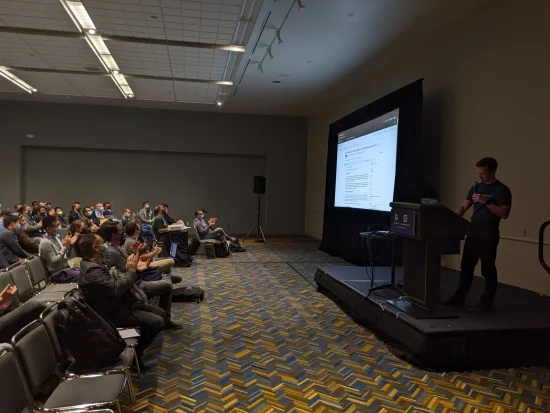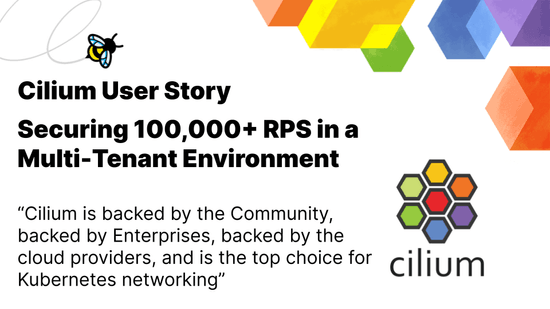eBPF Summit Day 2 Recap
eBPF Summit Day Two
After an exciting start with the first day of the eBPF Summit, the second and also final day of the summit this year was kicked off with another warm welcome from Thomas Graf, during which he reminded attendees:
Bees are nice. Be a bee.
Thomas set the stage for an incredible list of presenters for today's keynote talks, but not before announcing the winner of yesterday's trivia question Which mountain is behind Thomas in the video background? The correct answer was provided by Slack user Bala and they are receiving a cute plush bee as a reward. Some of the Slack user poll results were also presented and it was great to see that a lot of participants were completely new to eBPF. Naming suggestions for the eBPF mascot that we collected from the prior day also found a clear winner:

Full length video of the eBPF Summit, day two:
Safe Programs, the Foundation of BPF by Alexei Starovoitov (Facebook)
Alexei Starovoitov from Facebook kicked off the keynotes with his talk titled "Safe programs. The foundation of BPF." Alexei is the co-creator and co-maintainer of eBPF. Alexei's talk was focused on eBPF as a means of extending and programming the kernel, a much safer approach than with kernel modules. Thanks to the verifier, programs are checked for safety, ensuring they will not crash the kernel and bring the system to a halt.
Guaranteeing that safety isn't always easy. In particular, Alexei discussed how the compiler and verifier can play a game of cat and mouse. With each new optimization pass, the compiler obfuscates a little more the original intent of the programmer, making it harder for the verifier to validate the compiled bytecode is safe.
Alexei went on to explain how BPF Type Format (BTF) further strenghen that safety, by providing a form of type safety to the constrained BPF C language. What's next? Look out for new features in development, including the eBPF linker, eBPF libraries, and eBPF dynamic linking extensions. Alexei closed with a quote:
Maximum attention to safety in all aspects of BPF programming that's what makes it unique and that's why BPF is an undoubted choice today for kernel extensions and kernel programming.
Kernel Tracing in Production with Falco by Kris Nóva (Falco)
Following Alexei, Kris Nóva from Falco quickly stole the stage—or rather the presentation screen—to present her own screen sporting a retro hacker theme. Kris is a maintainer of the Falco project. Her talk title changed multiple times throughout the weeks leading up to the summit, finally landing on "How do we instrument the kernel without a kernel module in GKE?" Falco uses kernel instrumentation to trace what's happening in the kernel and publish alerts based on specific rules. To do this, a kernel module loaded on a host provides the necessary access. But what about GKE where there is no support for loading kernel modules on a host? This is where eBPF proved to be a natural solution. Falco developers wrote an emulation device using eBPF and were able to replace the kernel module. With an eBPF-based engine now able to run in place of the Linux kernel module, the other parts of Falco were able to plug in easily without much change. Kris went on to show some examples of Falco in action using a kernel module, eBPF with clang 9 and clang 10—the main purpose of the examples being to demonstrate the ease of moving between the different implementations and how they all work to alert about suspicious activity.
Performance Wins with BPF: Getting Started by Brendan Gregg (Netflix)
After the break, Brendan Gregg from Netflix presented on "Performance wins with BPF: Getting started." Brendan's primary goal is to help people find performance wins with eBPF quickly and easily. Many articles about eBPF aren't for beginners, but Brendan believes that, by thinking like sysadmins, not like programmers, everyone can benefit from eBPF. Brendan highlighted some tools we can explore that are available today, such as execsnoop to find periodic processes, opensnoop to find misconfigurations or files not found, tcplife to inspect TCP session details, ext4slower to find slow I/O performance, or biosnoop for finding block I/O performance bottlenecks. These tools are just a few examples of easily-accessible programs that can help find unusual activity for some quick wins. Beyond these examples, there is a huge selection of tools included in the bcc and bpftrace toolkits which can be easily leveraged for even more gains.
In a majority of cases, existing tools can solve the problem, but when they can't then it's time to think like a programmer and build the solution. If you are just getting started today, Brendan suggests to start with bpftrace because it is concise and behaves like pseudo-code. If looking into bcc implementations, Brendan first recommends to check out libbpf-based tools for an implementation instead. Thanks to libbpf, Brendan was able to build opensnoop into a single 151KB binary.
Brendan believes the future of eBPF is in development in the form of GUIs which surface some of the same information, but use eBPF under the hood. He believes that the ability to surface this data to operators or users, with no knowledge of the intermediate system relying on eBPF, will open up new avenues. In closing, Brendan encourages everyone to think like a sysadmin, install bcc and bpftrace tools, run them, and get some wins. To dive even deeper into eBPF, you should pick up a copy of Brendan's books, "BPF Performance Tools" and "Systems Performance 2nd edition".
Kubernetes Network Policy Logging with eBPF by Zang Li (Google)
Zang Li from Google presented next on "Kubernetes Network Policy Logging with eBPF." Zang works on GKE and Anthos and is also a Cilium core project member. She started with an explanation of how Kubernetes network policies are implemented, along with an example policy and scenario. She went on to highlight how differences in implementation from one CNI provider to the next directly impact how policies are implemented, whether that is via iptables, eBPF, Open vSwitch, or some other implementation. In addition to enforcement, she added that security-conscious customers will want to be able to log events related to policy decisions.
For Google, it was important this happened with minimal impact to the data path. During their design phase, they quickly realized that iptables would not scale to satisfy their complex networking requirements. Cilium provided the flexibility and programmability they needed. In addition, its implementation of eBPF-based network policies meant that Google could remove all reliance on iptables from the data path. These factors ultimately led Google to select Cilium as the CNI provider for GKE and Anthos.
Zang went on to explain how Google has extended, and makes use of, the Cilium monitor infrastructure to extract and log useful data about network connections. To provide visibility and observability into network connectivity, Google uses Cilium monitor, which runs as a user space application and is able to access data made available by eBPF programs through a perf ring buffer. This buffer can contain any information they might need, such as event type, source, policy verdict, direction, and more. Google further optimized this process by only generating policy events on new connections, not on every packet observed, allowing for a detailed policy logging engine.
Thanks to the partnership between Google and Cilium, users can leverage this functionality on Google Kubernetes Engine today.
The Future of eBPF-based Networking and Security by Thomas Graf (Isovalent)
Thomas Graf, CTO and co-founder of Isovalent, closed the keynote talks with "The Future of eBPF-based Networking and Security." Before we can understand why eBPF is the future, we need to briefly look at history. In the 1990s, networking was almost entirely physical. It was also the time of dial-up modems. In 1999, iptables was created as a successor for ipchains. In 2003, VLANs came to be, the Xen hypervisor was born, and EMC bought VMWare. KVM was merged into the Linux kernel in 2007, as virtualization era was upon us. However, in the case of networking, almost nothing had changed. In 2009, the first release of Open vSwitch started the network virtualization era. In 2010, OpenStack was born. 2013 brought us Docker, which directly inherited networking from the virtualization layers and containers were initially treated like miniature VMs. In 2014, Kubernetes was born and deliberately did not make many networking implementation assumption. Despite this, Kubernetes was initially heavily based on iptables, a system that literally was designed 15 years prior when modems ruled.
In that same year, 2014, eBPF was initially introduced to the Linux kernel. 2015 saw Linux networking become programmable and, in 2016, XDP was merged into the kernel—and is now the base for many eBPF-based load balancing solutions. In 2016, Cilium project was first announced, designed entirely from scratch, with eBPF at its foundation. The transition was complete. We had moved from an era first built on top of physical servers, to an era based on virtual machines where software-defined networking was first born, to nowadays where the networking and security layers are built specifically for cloud-native workloads. Google's adoption of the eBPF-based Cilium project for its flagship Kubernetes products GKE and Anthos is a great example on how eBPF plays a central role in networking and security for Kubernetes and cloud-native environments.
What's next? Thomas believes the industry will start to focus on edge load balancing with eBPF and XDP. He sees continuing opportunities to improve application awareness by further improving pod-to-pod and socket-to-socket networking. Similarities between API and system calls will lead to a more unified approach to network and system security, with less separation of concerns between policy, enforcement and alerting. Finally, he sees an opportunity to bridge physical and virtualized or containerized workloads, as well as eBPF-based service meshes being implemented more in the kernel.
For the Cilium project, it has been an exciting trip over the past 4 years. It's almost certain to become more exciting as eBPF opens up additional possibilities, not just for networking but for all forms of observability, security, tracing, and so much more.
Lightning Talks
After another break, we returned for another incredible round of lightning talks, all of which were just 5 minutes in length but were absolutely full of amazing content:
- Giulia Frascaria (Vrije Universiteit Amsterdam) - Can eBPF Save us from the Data Deluge? A Case for File Filtering in eBPF
- Timo Reimann (Digital Ocean) - From Managed Kubernetes to App Platform: 1.5 Years of Cilium Usage at DigitalOcean
- Zain Asgar (Pixie) - Debugging Go in Prod with eBPF
- Martynas Pumputis (Isovalent) - North-South Load Balancing of Kubernetes Services with eBPF/XDP
- Luan Guimarães (Wildlife Studios) - Global Gaming Infrastructure with Cilium
- Ramiro Berrelleza (Okteto) - The Tale of Smokey and the Crypto Bandits
- Vlad Ungureanu (Palantir) - Past, Present, and Future of Cilium and Hubble at Palantir
- Itay Shakury (Aqua Security) - Tracing and Detecting Malware using eBPF
- Natalia Reka Ivanko (Isovalent) - Identity Aware Threat Detection and Network Monitoring by using eBPF
- William Findlay (Carleton University) - bpfbox: Simple Precise Process Confinement with eBPF and KRSI
- Lorenz Bauer (Cloudflare) - How to Ship BPF with your Go Project
- Yutaro Hayakawa (LINE) - eBPF at LINE's Private Cloud
- Dinesh Venkatesan (Microsoft) - Building a Behavioral Knowledge Graph using eBPF
- Andrey Ignatov (Facebook) - Containers and BPF: twagent story
We hope you had as much fun attending the eBPF Summit as we did hosting it. We'd like to give a huge thanks to everyone who attended, all of our speakers and the amazing team of people who worked in the background to support the event and make it a success.
For more information about eBPF, you can visit the ebpf.io website or join us on Slack.


